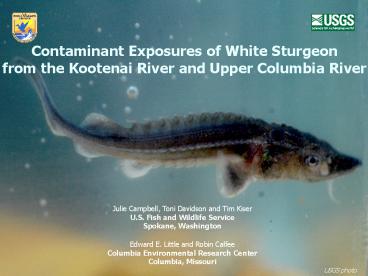Julie Campbell, Toni Davidson and Tim Kiser - PowerPoint PPT Presentation
1 / 20
Title: Julie Campbell, Toni Davidson and Tim Kiser
1
Contaminant Exposures of White Sturgeon from the
Kootenai River and Upper Columbia River
Julie Campbell, Toni Davidson and Tim Kiser U.S.
Fish and Wildlife Service Spokane,
Washington Edward E. Little and Robin
Calfee Columbia Environmental Research
Center Columbia, Missouri
USGS photo
2
Background
- Investigate contaminant exposure as a potential
contributing factor in recruitment failure of
Kootenai River white sturgeon - Chlorine discharges from water treatment
facilities in range of 300 500 mg/L - Kootenai Tribe of Idaho concerns over chemicals
proposed for Eurasian watermilfoil treatment - USGS and USFWS Recovery Initiative partnership
- KTOI and WDFW provided hatchery fish
3
Objectives
- Determine sensitivity of white sturgeon from the
Kootenai River to chlorine and copper in
laboratory (2007-08) - Evaluate behavioral avoidance response to
chlorine and copper (2008-09) - Evaluate actual concentrations of chlorine and
metals from municipal discharges in Kootenai
River and compare to sturgeon toxicity data
(2008)
4
Objectives
- Determine sensitivity of Kootenai River white
sturgeon to 3 herbicides proposed for treatment
of Eurasian watermilfoil - Compare toxicity data to recommended application
rates for herbicides - Determine effectiveness of rainbow trout as a
surrogate for white sturgeon, through comparative
tests
USGS photo
5
Toxicity Test Methods
Conduct flow-through toxicity tests with two life
stages of KRWS or CRWS and rainbow trout
exposed to copper or chlorine over 96 hours
- Conduct static toxicity tests with two life
stages of KRWS and rainbow trout exposed over 96
hours to the herbicides - - 2,4-D (2,4-DMA4IV, Dow AgroSciences LLC)
- - triclopyr (Renovate, SePRO Corporation)
- - fluridone (Sonar, SePRO Corporation)
6
Toxicity Test Methods
- Two life stages tested
- - 30 days post swim-up
- - 160 days post swim-up
- Chlorine and copper exposures were conducted in a
water hardness of approximately 100 mg/L as CaCO3 - Herbicides exposures were conducted in a water
hardness of approximately 260 mg/L as CaCO3 - Measured variables
- - Loss of equilibrium
- - Mortality
- - Toxicant concentration
- - Water quality
USGS photo
7
Results Chlorine
96-h LC50 (ug/L)
Days Post-swimup
Max daily ambient water quality criteria 19 ug/L
8
Results Copper
96-h LC50 (ug/L)
Days Post-swimup
Acute water quality criteria 13 ug/L
9
Results 2,4-D
96-h LC50 (mg/L)
Days Post-swimup
Maximum recommended application rate 4.0 mg/L
10
Results Fluridone
96-h LC50 (mg/L)
Days Post-swimup
Recommended application rate 0.15 mg/L
11
Results Triclopyr
96-h LC50 (mg/L)
Days Post-swimup
Recommended application rate 2.5 mg/L
12
Conclusions
- Chlorine/Copper
- Kootenai River sturgeon and Columbia River
sturgeon were similarly sensitive to chlorine at
concentrations below those that affect rainbow
trout sensitivity of older lifestage similar to
early lifestage. - Early lifestage sturgeon were highly sensitive to
copper at concentrations considerably lower than
those that affect rainbow trout, and below AWQC
of 13 ug/L. - Older lifestage sturgeon were relatively
insensitive to copper at concentrations higher
than those affecting rainbow trout. - Tests repeated in 2008 with similar results
13
Conclusions
- Herbicides
- White sturgeon were consistently more sensitive
to herbicides than rainbow trout. - Early lifestage sturgeon were consistently more
sensitive to herbicides than older lifestage
sturgeon. - Although herbicide treatments were not lethal to
(older) fish, significant behavioral impairments
resulting from exposure would limit survival.
USGS photo
14
Conclusions
- Herbicides
- Triclopyr - lowest probability of causing adverse
effects to white sturgeon at the maximum
recommended application rate. - Fluridone and 2,4-D - 5 sturgeon mortality at
concentrations less than the recommended
application rates. - Additional data addressing sub-lethal and lethal
effects to sturgeon from exposure to fluridone
and 2,4-D. - Rainbow trout are not necessarily an adequate
surrogate for white sturgeon in laboratory
toxicity tests
15
How are these studies relevant to UCR white
sturgeon?
- Copper
- Early lifestage sturgeon in contact with pore
water during hiding phase, refuge from predators - USGS (Paulson and Cox 2007) evaluated transfer of
metals from UCR sediments to interstitial and
overlying waters throughout Lake Roosevelt - 3 contact scenarios evaluated
- interstitial water (within top 2 cm of
sediment) - incubated water (32 d incubation of sediment
cores) - tumbled sediment/water (aggressively mixed with
sediment for 43 d)
16
Copper vs. ELS sturgeon
Observed ELS Sturgeon LC50
Data from Paulson and Cox 2007
17
Herbicides
- Any proposal for treatment of Eurasion
watermilfoil in sturgeon-inhabited areas of the
Upper Columbia River should consider the findings
of herbicide toxicity studies - Of the three herbicides evaluated, triclopyr has
lowest probability of causing adverse effects to
white sturgeon at the maximum recommended
application rate. - Additional data addressing sub-lethal and lethal
effects to white sturgeon from exposure to
fluridone and 2,4-D are needed.
18
2008 On-going investigations
- Chlorine/Copper behavioral avoidance
- (USFWS Recovery Initiative Funding)
- 160 dps sturgeon exposed to ranges of
concentrations - Counter-current avoidance apparatus
USGS photo
19
2008 On-going investigations
- Acute Toxicity of Columbia River
slag-contaminated sediments (USGS NW Flex
Fund) - 96-hour acute toxicity tests, 30 dps sturgeon,
5 UCR sites - Test 1 slag leachate aged 7 days, mixed
daily - Test 2 fish exposed to sediment/slag
- with fresh water
Test 1
Test 2
USGS photos
20
2008 On-going investigations
- Columbia River slag behavioral avoidance
- (USGS NW Flex Fund)
- 30 dps sturgeon exposed to slag-contaminated
sediments - Counter-current avoidance apparatus with slag
substrate - Dark, course aquarium sand used as control
- All data currently being analyzed
- Additional evaluations planned for 2009































